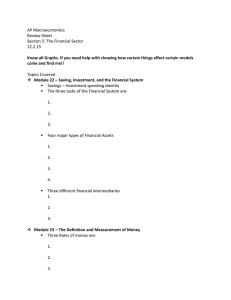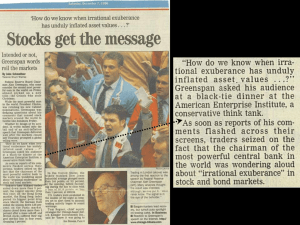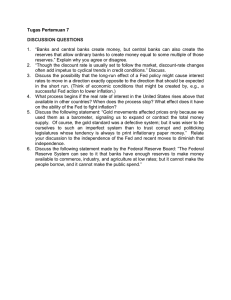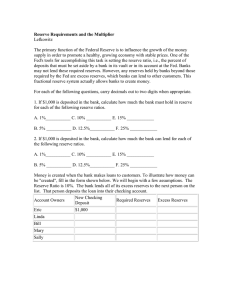Federal Reserve System: Structure, Functions, Monetary Policy
advertisement
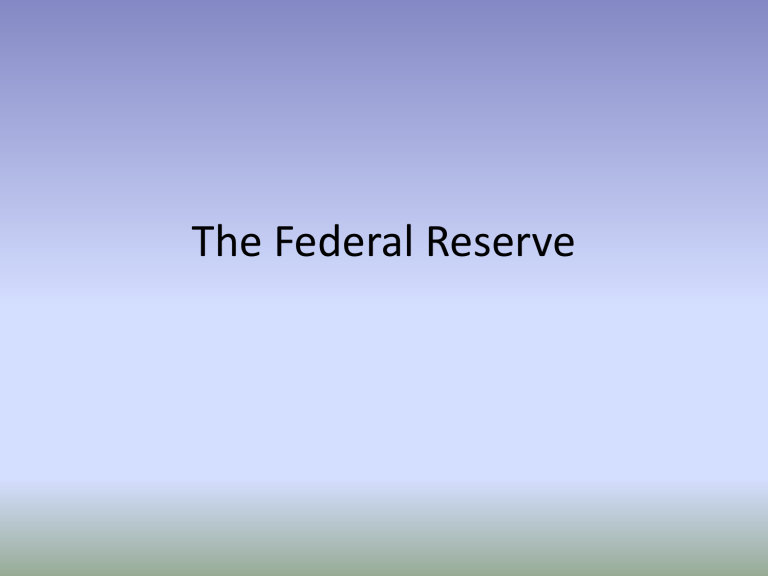
The Federal Reserve Background • The Federal Reserve serves as the central bank of the United States – An institution that oversees & regulates the banking system & controls the monetary base • The Federal Reserve was created with the Federal Reserve Act of 1913 – Created in response to the banking crisis of 1907 Structure of the Federal Reserve 1. The Board of Governors – Most important body of the Fed – Appointed by the President and confirmed by the Senate – Members serve one 14 year term and terms are staggered so one person is being replaced every 2 years – The President also elects a Chairman • He/she serves a 4 year term but it can renewed 4 times Structure of the Federal Reserve 2. The Federal Open Market Committee (FOMC) – The policy making arm of the Fed • Sets the monetary policy and directs the purchase & sale of government securities (bills, notes, and bonds) – Comprised of the 7 Board of Governors plus five of the presidents from the Federal Reserve Banks – Typical Meeting – The entire committee [12 members + other 8 bank presidents] examine regional, national and international economic info to assess the strengths and weaknesses of the economy. – After discussing the economy, the voting members vote on the direction of monetary policy. A policy directive describes the committee’s assessment of the economy and the new target fed funds rate. – An announcement is made about 1:15 p.m. Structure of the Federal Reserve 3. The 12 Federal Reserve Banks – They serve collectively as the central bank – They are Quasi-Public • Blends private ownership & public control • Private commercial banks buy membership into the Federal Reserve System – They purchase shares of stock in the Federal Reserve Bank in their district • However, the Board of Governors (appointed by the Govt) set the basic policies that the Fed pursues Alaska and Hawaii are part of the San Francisco District Paper notes printed at: 1. FW Currency Center 2. Washington D,C. Coins minted at: 1. Denver 2. Philadelphia 3. San Francisco 1st-A-Boston (0) 2nd-B-New York (1) 3rd-C-Philadelphia (0) 4th-D-Cleveland (2) 5th-E-Richmond (2) 6th-F-Atlanta (5) 7th-G-Chicago (1) 8th-H-St. Louis (3) 9th-I-Minneapolis (1) 10th-J-Kansas City (3) 11th-K-Dallas (3) 12th-L-San Francisco (4) Structure of the Federal Reserve 4. Member Banks – The Fed is known as the bank of banks – The perform the same functions for banks that private banks perform for individuals • Accepts deposits • Makes loans The Functions of The Fed 1. Provide Financial Services – Serves as the bank of banks and the bank of the gov 2. Supervise & Regulate Banking Institutions 3. Maintain the stability of the Financial System – Provides liquidity to financial institutions to ensure their safety and soundness 4. Conduct Monetary Policy (most important function) Tools of Monetary Policy 1. Reserve Requirement – The Fed can change this requirement for all checking, time, or savings accounts in the country • The lower the reserve requirement, the greater money available to be loaned out • The higher the reserve requirement, the less money available to be loaned out Tools of Monetary Policy 2. Discount Rate – The interest rate the Fed charges on loans to financial institutions • Individuals & businesses can’t borrow money from the Fed but banks can • If the Fed raises the discount rate, fewer banks will want to borrow and fewer funds will be available to loan their customers Tools of Monetary Policy 3. Open Market Operations (most popular) – The buying & selling of government securities (bonds) in financial markets • When the Fed purchases government bonds the money supply increases and puts downward pressure on interest rates – Buying Bonds = Bigger Bucks • When the Fed sells government bonds, the money supply decreases – Selling Bonds = Smaller Bucks Money: Definitions, Measures, Time Value + Introduction to Quantity Theory A quick primer on the number TRILLION: • $1 trillion = $1,000 billion or $1,000,000,000,000 (that's 12 zeros) • How hard is it to spend a trillion dollars? If you spent one dollar every second, you would have spent a million dollars in 12 days. At that same rate, it would take you 32 years to spend a billion dollars. But it would take you more than 31,000 years to spend a trillion dollars. • And now, some scary facts about the debt and the deficit -- some basics: • Deficit = money government takes in -- money government spends • 2012 US deficit = $1.33 trillion • 2013 Proposed budget deficit = $901 billion • National debt = Total amount borrowed over time to fund the annual deficit • Current national debt = $16.1 trillion (or $51,645 per every man, woman and child in the US or $141,727 per taxpayer) Money Defined • Money is anything that can be used as: – A medium of exchange (can be used in exchange goods & services) – A store of value (used to accumulate wealth) – A unit of account / Standard of Value (used to measure & compare) • Money works best when it meets these criteria: – Portable – Durable – Divisible – Acceptable – Stable Money Facts: • What backs the dollar and makes it valuable? – Gold? – NO! The dollar is legal tender because the government says it’s money and people willingly accept it. The Dollar is backed by FAITH. – This is referred to as an inconvertible fiat standard. The Supply of Money • In the United States, the Federal Reserve System is the sole issuer of currency. – This means the Fed has monopoly control over the money supply. • There are two important measures of the Money Supply today. – M1 – M2 M1 • M1 serves primarily as a medium of exchange. It includes: – Currency and Coin – Demand Deposits M2 M2 serves as a store of value. It includes: – The M1 – Time Deposits (small denomination CD’s) – Money Market Mutual Funds M1 & M2 • As we go from M1 to M2 – The measure becomes larger – Money becomes less liquid • As we go from M2 to M1 –The measure becomes smaller – Money becomes more liquid Time Value of Money • Is a dollar today worth more than a dollar tomorrow? – YES • Why? – Opportunity cost & Inflation – This is the reason for charging and paying interest Time Value of Money • Let v = future value of $ p = present value of $ r = real interest rate (nominal rate – inflation rate) expressed as a decimal n = years k = number of times interest is credited per year • The Simple Interest Formula n v=(1+r)*p • The Compound Interest Formula nk v = ( 1 + r/k ) * p Relating Money to GDP • Economist, Irving Fisher postulated that : Nominal GDP = The Money Supply * Money’s Velocity The Monetary Equation of Exchange • MV = PQ – M = money supply (M1 or M2) – V = money’s velocity (M1 or M2) • Average # of times per year a dollar is spent in a year – P = price level (PL on the AS/AD diagram) – Q = real GDP ( sometimes labeled Y on the AS-AD diagram) – P*Q or PQ = Nominal GDP The Monetary Equation of Exchange • MV=PQ – M1=$2 trillion – V of M1 = 7 – PQ = $14 trillion The equation of exchange has two primary uses. It represents a founding principle used by the quantity theory of money, which relates increases in the money supply to increases in the overall level of prices. Additionally, solving the equation for 'M' can serve as an indicator of the demand for money Free Response Practice 1. Assume that the United States economy is currently in a recession in a short-run equilibrium. (b) Draw a correctly labeled graph of aggregate demand and aggregate supply in the recession and show each of the following. (i) The long-run equilibrium output, labeled Yf (ii) The current equilibrium output and price levels, labeled Ye and PLe, respectively (c) To balance the federal budget, suppose that the government decides to raise income taxes while maintaining the current level of government spending. On the graph drawn in part (b), show the effect of the increase in taxes. Label the new equilibrium output and price levels Y2 and PL2, respectively. (e) Now assume instead that the government and the Federal Reserve take no policy action in response to the recession. (i) In the long run, will the short-run aggregate supply increase, decrease, or remain unchanged? Explain. (ii) In the long run, what will happen to the natural rate of unemployment? (b) 2 points: • One point is earned for a correctly labeled graph of AD/AS showing the equilibrium output, Ye, and price level, PLe. • One point is earned for showing Yf to the right of Y . e (c) 1 point: • One point is earned for showing a leftward shift of the AD curve and indicating Y and PL . 2 2 (e) 2 points: • One point is earned for stating that the short-run aggregate supply will increase because wages and other input prices will decrease. • One point is earned for stating that the natural rate of unemployment remains unchanged. 1. Assume that the economy of Meekland is in a long-run equilibrium with a balanced government budget. (a) Using a correctly labeled graph of aggregate supply and aggregate demand, show each of the following. (i) Long-run aggregate supply (ii) The output level, labeled YE, and the price level, labeled PLE (b) Assume consumer confidence falls. Show on your graph in part (a) the short-run impact of the change in consumer confidence and label the new equilibrium price level and output Y1 and PL1, respectively. (d) If the government and the central bank do not pursue any discretionary policy change, how does the fall in consumer confidence affect government transfer payments in Meekland? Explain. (f) In the absence of any changes in fiscal and monetary policies, in the long run will the short-run aggregate supply curve shift to the left, shift to the right, or remain unchanged as a result of the fall in consumer confidence? Explain. (a) 2 points: • One point is earned for drawing a correctly labeled graph of AD and SRAS and showing PLE. • One point is earned for showing a vertical long-run aggregate supply curve (LRAS) at YE. (b) 1 point: • One point is earned for showing a leftward shift of the AD curve and showing the new equilibrium price level, PL1, and output, Y1. (d) 1 point: • One point is earned for stating that transfer payments will increase because more people will apply for government benefits. (f) 1 point: • One point is earned for stating that the short-run aggregate supply curve will shift to the right because wages and other input costs will fall. 3. Assume the economy of Andersonland is in a long-run equilibrium with full employment. In the short run, nominal wages are fixed. (a) Draw a correctly labeled graph of short-run aggregate supply, long-run aggregate supply, and aggregate demand. Show each of the following. (i) Equilibrium output, labeled Y1 (ii) Equilibrium price level, labeled PL1 (b) Assume that there is an increase in exports from Andersonland. On your graph in part (a), show the effect of higher exports on the equilibrium in the short run, labeling the new equilibrium output and price level Y2 and PL2, respectively. (c) Based on your answer in part (b), what is the impact of higher exports on real wages in the short run? Explain. (d) As a result of the increase in exports, export-oriented industries in Andersonland increase expenditures on new container ships and equipment. (i) What component of aggregate demand will change? (ii) What is the impact on the long-run aggregate supply? (a) 2 points: • One point is earned for drawing a correctly labeled graph and showing the AD and SRAS curves and PL1. • One point is earned for showing a vertical LRAS curve at the output Y1 through the intersection of the SRAS and AD curves. (b) 1 point: • One point is earned for showing a rightward shift of the aggregate demand curve and showing Y2 and PL2. (c) 1 point: • One point is earned for stating that real wages will fall because the price level has increased and the nominal wages are fixed in the short run. (d) 2 points: • One point is earned for stating that the investment component of AD will change. • One point is earned for stating that the long-run aggregate supply curve will shift to the right because the capital stock has increased. Banking & Money Creation Fractional Reserve Banking O A system in which only a fraction of the total money supply is held in reserve as currency O All banks are required by law to keep required reserves O Funds held in the bank vault or deposited with the Fed to meet the legal reserve requirements O The current reserve requirement is 10% O Reserve Ratio (rr) – the fractions of total deposits kept on reserve O rr = required reserves / total deposits O How do banks create money? O By lending out deposits that are used multiple times, just like the Consumption Multiplier Effect (1/1-MPC or 1/MPS) O Where do the loans come from? O From depositors who take cash and place it in accounts at banks O How are the amounts of potential loans calculated? O By understanding and applying the bank balance sheet system, also known as a “TAccount” T-Accounts O Creating a T-Account (balance sheet) allows us to see how banks create money O T-Accounts show the assets and liabilities of the bank O Bank assets must equal liabilities Assets Liabilities Liabilities O Anything owned by the depositor or lenders to the bank 1. 2. Demand Deposits (cash deposits from the public) Owners Equity (the values of stock held by public ownership of the bank) O Key concept concerning Liabilities: O If the demand deposit comes in from someone’s “cash” holdings, then that demand deposit is already part of the Money Supply (M-1). The cash is simply being placed into a bank account. O If the demand deposit comes in from the purchase of bonds (by the Fed) then this creates new cash and therefore creates new Money Supply (M-1). Assets O Anything owned by the bank or owed to the bank O Examples 1. 2. 3. 4. 5. Required Reserves (percentage of demand deposits that must be left in the bank vault) Excess Reserves (monies leftover from a demand deposit after the required reserves; can be used by the bank as a loan Loans (funds that have already been given out from old Excess Reserves) Bonds (funds that banks have previously purchased from the Federal Reserve) Buildings and Fixtures (values of bank property) O Katie takes $1000 and deposits it into her checking account at ECB. ECB must put $100 in required reserves, but the remaining $900 of excess reserves can be kept on reserve or lent. Assets Required Reserves - $100 Excess Reserves - $900 Liabilities Demand Deposits - $1000 Total Assets - $1000 Total Liabilities - $1000 O ECB lends all $900 in excess reserves to Bob. (This loan does not count as newly created money yet) Assets RR - $100 ER - $0 Loans - $900 Total Assets - $1000 Liabilities DD - $1000 Total Liabilities -$1000 O Bob uses his $900 at Tractor Supply. They have an account with ECB and deposit the $900. Demand Deposits have increased $900. ECB must keep $90 as required reserve and there are now $810 in excess reserve. Assets Liabilities RR - $190 DD - $1900 ER - $810 Loans - $900 Total Assets - $1900 Total Liabilities - $1900 The Money Multiplier O Banks can generate profit by lending the excess reserves and collecting interest payments. Each successive bank must pull some of the money out for required reserves. A rough estimate of the number of loan amounts created by any first loan is the “monetary multiplier”. O The formula is simple: 1divided by the reserve requirement (ratio) An example = RR = 10% = 1/.1 = Monetary Multiplier of 10. O Excess Reserves are multiplied by the Multiplier to create new loans for the entire banking system and this creates new Money Supply. O ER x (1/rr) 3. Assume that the reserve requirement is 20 percent and banks hold no excess reserves. (a) Assume that Kim deposits $100 of cash from her pocket into her checking account. Calculate each of the following. (i) The maximum dollar amount the commercial bank can initially lend (ii) The maximum total change in demand deposits in the banking system (iii) The maximum change in the money supply (b) Assume that the Federal Reserve buys $5 million in government bonds on the open market. As a result of the open market purchase, calculate the maximum increase in the money supply in the banking system. (c) Given the increase in the money supply in part (b), what happens to real wages in the short run? Explain. (a) 3 points: • One point is earned for stating that the maximum dollar amount the bank can initially lend is $80. • One point is earned for stating that the maximum change in demand deposits is $500. • One point is earned for stating that the maximum change in the money supply is $400. (b) 1 point: • One point is earned for stating that the Federal Reserve’s action will increase the money supply by at most $25 million. (c) 2 points: • One point is earned for stating that the real wages will fall. • One point is earned for explaining that real wages fall because the Federal Reserve’s action causes inflation. The Money Market & Loanable Funds The Money Market • The market where the Fed and the users of money interact thus determining the nominal interest rate (i%). • Money Demand (MD) comes from households, firms, government and the foreign sector • The Money Supply (MS) is determined only by the Federal Reserve. Types of Money Demand • Transaction Demand – D for $ as a medium of exchange • Asset Demand – D for $ as a store of value (dependent on the interest rate). • Total Money Demand – (MD) is downward sloping because at high i% people are less inclined to hold $ and more inclined to hold stocks & bonds. At lower i% people sacrifice less when they hold $. The Money Supply • The MS is determined by the Fed b/c the Fed has a monopoly over the supply of money. • The Fed’s monopoly is the reason for the vertical MS curve The Money Market Graph • The equilibrium of MS & MD determines the nominal interest rate (i%). • MD is downward sloping because the nominal interest rate is the opportunity cost of holding money. • MS is vertical because it is independent of the interest rate. Shifts in MD 1. Changes in PL (price level) – The higher the price level the more money we will hold onto (curve moves to the right) 2. Change in Real GDP – Real GDP increases the curve moves to the right Supply Shift • Only the Fed determines the money supply • Contractionary Monetary Policy – MS shifts to the left – i% increases – Res. Ratio increase – Disc. Rate increase – Sell Bonds = small bucks = MS decreases Supply Shift Cont. • Expansionary Monetary Policy – MS shifts to the right – i% decrease – Res. Ratio decrease – Disc. Rate decrease – Buy Bonds = Big bucks = MS increases Loanable Funds • The market where buyers and savers meet to exchange funds (QLF) at the real interest rate (r%) • Both the demand & supply for LF, or borrowing, comes from households, firms, the government, and the foreign sector – Demanders for loanable funds are also the suppliers of bonds – Suppliers of loanable funds are also the demanders of bonds Changes in the demand of LF • More borrowing = more demand for LF – Shifts the DLF curve to the right – Example: • government deficit spending = more borrowing = more demand for loanable funds • When the demand curve shifts right the r% increases • Less borrowing = less demand for LF – Shifts the DLF curve to the left – Example: • Less investment demand= less borrowing = less demand for loanable funds • When the demand curve shifts left the r% decreases Changes in the Supply of LF • More saving = more supply of loanable funds – Example: • Government budget surplus = more saving = more supply of loanable funds • SLF curve shifts to the right and r% decreases • Less saving = less supply of loanable funds – Example: • Decrease in consumers MPS = less saving = less supply of loanable funds • SLF curve shifts to the left and r% increases • The LF market determines the real interest rate (r%) • Changes in savings and borrowing change LF and therefore the r% • Changes in r% will affect investment (Ig) • When the government enacts fiscal policy it will affect the LF market Crowding Out • What is it? – A critique and flaw of Keynesian policies that are applied to fight a recession. (An expansionary policy!) • Why does it happen? – The policy of cutting Taxes and raising Spending will create a budget deficit. • So? – The budget deficit must be funded and to do this Congress orders the sale of US bonds. (This is NOT a Monetary Policy tool used by the Fed) Crowding Out • Where does the money come from? – Mostly from US citizens and companies and investment firms. (Some from foreign countries) • Therefore? – Money that could be spent on Consumption (C) or used for Private Savings is now being used to buy bonds. • On the money market – This will cause the Money Demand curve to shift outward. Remember this is a Fiscal event! Crowding Out • One the loanable funds market? – This will cause the Supply curve to shift inward because we are not Saving money privately any more. • Also on the loanable funds – This can cause the Demand curve to shift outward because the private and public demand for $ increases_. • On both graphs – The nominal and real interest rate will increase. Crowding Out • Therefore on the Investment D graph – The increase in nominal and real interest rates will cause Ig to decrease. • Is this counterproductive? – Yes • Why do it? – Fiscal Policy supporters (Keynesians) insist that gains in C and G will outweigh any loss in future Ig. Crowding Out • Why? – C and G are greater than Ig and they are Short Run improvements. Ig is longer run and Keynesians don’t worry about that. In the long run we are all dead. • Anymore – Yes, this is summarized on the Aggregate Model. The AD will move outward due to the increases in C and G and then “maybe” move inward due to a loss of Ig, but not as much as the increase. Therefore the economy improves.


